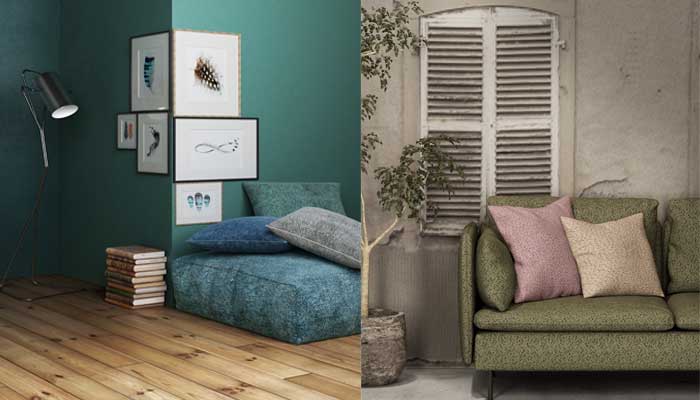
Redefining Interiors Sustainably
Eco-friendly textiles provide environmental credibility along with a distinct warmth and authenticity inherent in natural materials, says Rohit Khemka.
Sustainable home textiles are pioneering a new era in interior design in a society where our choices have an impact. Today, our attention in interior design has changed from focusing on style and trends to making homes that represent our unique preferences and beliefs, turning them into safe havens. Environmentally friendly textiles are changing people’s perceptions of creating a comfortable and environmentally conscious space. Eco-friendly textiles are transforming our living spaces and adding a feeling of importance, attractiveness, and serenity to our daily routines.
What makes a textile sustainable?
Environmentally conscious materials elevate the appearance of our houses and incorporate a chic element of sustainability. These products are skillfully made with sustainable materials like organic cotton, linen, and recycled polyester. These environmentally friendly materials require fewer chemicals, water, and energy because they are sustainable in nature. Choosing long-lasting materials equals saying no to unnecessary waste and embracing a timeless aesthetic in our living spaces.
Reducing our environmental footprint
Opting for sustainable materials signifies a deliberate choice to decrease our environmental impact. Manufacturing fabric through conventional methods requires a significant amount of water, energy, and chemical dyes. More consideration is given to the environment in the production of sustainable textiles, with organic cotton conserving water, natural dyes decreasing chemical pollution, and recycled materials reducing waste. Every intentionally crafted piece adds to the beauty and eco-friendliness of the environment.
The art of lasting design
Understanding that a cherished material will withstand the test of time is especially appealing. Sustainable materials like hemp, linen, and organic cotton are created with durability in mind. Unlike fabrics that fade quickly, these durable options become more beautiful with age, bringing warmth and character to our homes year after year. Focusing on lasting quality involves more than just saving money; it means choosing products that improve our lives and reducing waste.
Healthier homes, happier living
Environmentally friendly fabrics allow us to establish a refuge within our living space. Opting for natural, untreated fibres rather than harsh chemicals aids in the enhancement of indoor air quality by eco-friendly textiles. Organic cotton, wool, and linen are natural fabrics without harmful chemicals commonly found in traditional textiles, making them perfect for delicate spaces like nurseries, bedrooms, and living rooms. Choosing sustainable options allows us to unwind and experience tranquillity within our personal spaces.
Nature’s palette
Eco-friendly textiles provide environmental credibility along with a distinct warmth and authenticity inherent in natural materials. Organic colours and natural elements such as linen, jute, and cotton establish a peaceful link to the outdoors. These soft, earthy tones easily complement various interior design aesthetics, spanning from simple to eclectic. Selecting fabrics that reflect the simplicity and elegance of the outdoors can create a sense of grounding and peace in our homes.
Handcrafted heritage
Sustainable textiles often tell a story, created by expert craftsmen who preserve the traditional methods of their culture. Each handmade rug, pillow, or throw represents the skill and dedication of artisans in preserving traditional techniques for the generations to come. These objects enhance a room with character and depth, showing how our choices support people, their talents, and the maintenance of cultural heritage. Sustainable textiles not only offer fashion but also help us incorporate impactful beauty in our homes.
Textile versatility
Sustainable fabrics seamlessly blend into all areas of the home, from gentle organic sheets in the bedroom to durable hemp upholstery in the living room. Linen curtains provide a fresh and airy feel to windows, while jute rugs offer strength and appeal to busy areas. Fabric choices that are mindful of the environment allow us to design areas that are cohesive, practical, and produced ethically. There are numerous choices available, which makes it simple to discover items that represent your individual style and beliefs.
The future of textiles
The sustainable textile industry is brimming with creativity, introducing new materials that break limits. Materials crafted from surprising origins like pineapple leaves, seaweed, and coffee grounds are now becoming part of the eco-conscious movement. All of these innovative, nature-influenced materials showcase creativity and adaptability, showing that environmentally-friendly options can be unique, unexpected, and enjoyable.
Creating tomorrow’s spaces today
Sustainable home textiles have shown us that attractive designs can also prioritise environmental consciousness. Every environmentally conscious decision in our decoration reflects our dedication to improving the planet and creating a more optimistic tomorrow. By using sustainable materials, we are changing the definition of luxury to focus on quality, awareness, and responsibility instead of extravagance. These decisions influence environments filled with meaning, turning our residences into spaces that are visually appealing and functional.
Choosing sustainable materials allows us to build a heritage and surroundings that reflect our beliefs, making a visually pleasing and mindful living area. Let’s work together to create a future in which our homes demonstrate our concern for the environment, making thoughtful decisions along the way.
About the author:

Rohit Khemka is the Founder of RR Décor. Known as a pioneer in bringing about a change in how people view and use Bhagalpur silks, Khemka has established a name for himself in the interior furnishing industry.




